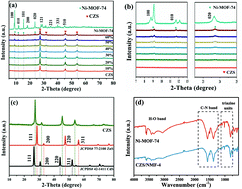0D/2D spatial structure of CdxZn1−xS/Ni-MOF-74 for efficient photocatalytic hydrogen evolution
Abstract
A novel zero-dimensional/two-dimensional CdxZn1−xS/Ni-MOF-74 (CZS/NMF) heterojunction was rationally constructed via a simple hydrothermal and physical mixing method. The results show that the CZS/NMF-4 composite has the best photocatalytic hydrogen evolution performance, generating 1712.3 μmol of hydrogen within 5 h, approximately 10 times higher than the amount generated by pure CZS. This extraordinary enhanced photocatalytic hydrogen activity can be ascribed to the constitution of the direct Z-scheme heterojunction and the small size effect, as well as the intimate contact between the 0D CdxZn1−xS nanoparticles and the 2D Ni-MOF-74 sheets. The formation of the direct Z-scheme heterojunction can effectively reduce the migration resistance of light-generated carriers and dramatically promote the separation of photo-induced electrons and holes. Meanwhile, the size effect shortens the electron transfer distance which effectively decreases the recombination possibility of photo-induced electron–hole pairs. Furthermore, the 0D/2D spatial structure of CZS/NMF-4 dramatically reduces the agglomeration of CZS nanoparticles, which provides more active sites for the process of hydrogen evolution. In general, this work provides new inspiration for the application of combinations between progressively developing new MOF materials and the traditional CdxZn1−xS photocatalyst according to the construction of a special spatial structure.



 Please wait while we load your content...
Please wait while we load your content...